How does the stylus Galaxy Note
From the first day of use, I was very interested in the question - how on the usual capacitive screen, which only a certain area of touch perceives, was it possible to achieve the work of a thin stylus, and even with a button and several degrees of depression?
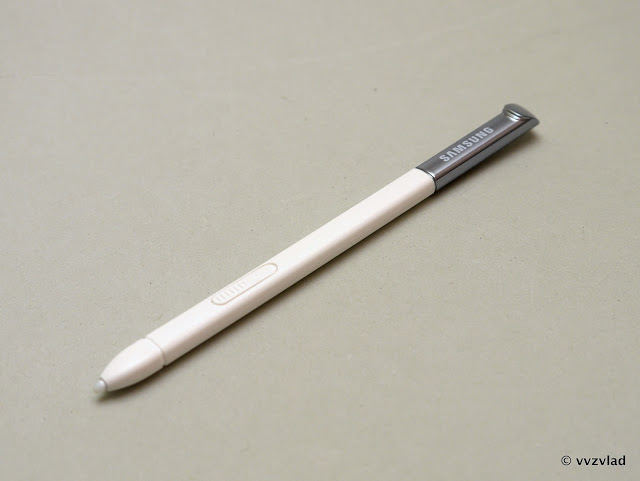
In this article I will try to answer this question by telling a little about interesting technical solutions used in this phone.
To begin, remember the theory.
The capacitive screen determines the point of contact for leakage current when charging a capacitor, the role of one facing of which is the screen of the phone and the other - the human body. On the reverse side of the glass in your smartphone are thin lines of transparent conductive material (you can see them if you look at a certain angle on the screen in good light).
Capacitive sensor: mini-capacitors (in the form of the letter H) and conductors in between.
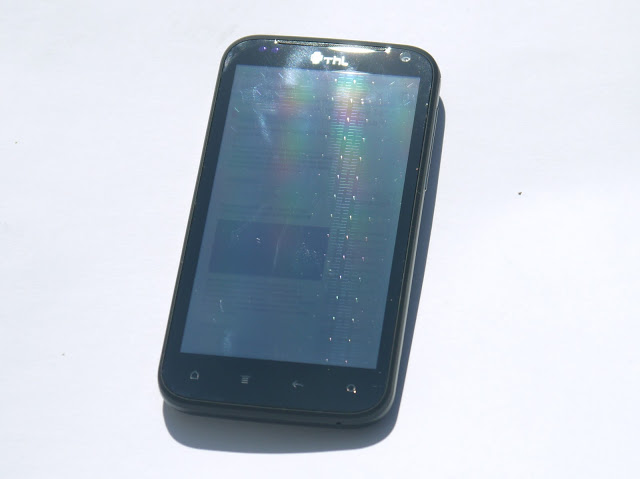
')
The touch screen controller charges and discharges these capacitors with a limited current many times per second, each time measuring the capacitance of each of them, and comparing it with the standard capacity recorded in memory. As soon as you touch your glass with your finger, you become such a large capacitor plate that you can charge.
Naturally, this will require energy, which the controller keeps a sharp eye on. As soon as he discovers that a cell begins to consume a lot of energy (a lot - this is compared to normal consumption, but even for a normal LED it is crumbs), which, with a limited current, turns into an increase in charge time - he realizes that they touched it.
On the basis of information from several capacitors, it is possible to calculate the place and area of contact by quite complex formulas. Or several touches, the number of simultaneously determined touches is limited only by the controller and the screen size (it is very difficult to fit 20 fingers on the screen in 3 ").
This technology has several limitations. For several reasons, such as the inability to position the elements tightly enough (transparency decreases), limited glass conductivity, and the need to cut off interference from accidental touches, pickups, dirt on the screen, etc. I had to be content with a minimum touch area of 5x5 mm.
In addition, an object that touches the screen must have a sufficient capacity of its own, comparable to the capacity of the human body. What do we get in the end? The inability to use gloves (most of them have a sufficiently large resistance to reduce leakage current to a minimum that is not determined by the controller), the need for large styli, which must be galvanically connected to the user's body (therefore, most of them have a metal case).
What input systems work with stylus, can distinguish the force of pressing, and have excellent accuracy? These are electromagnetic antenna systems that are used in the vast majority of graphics tablets.
Wacom graphic tablet with stylus:
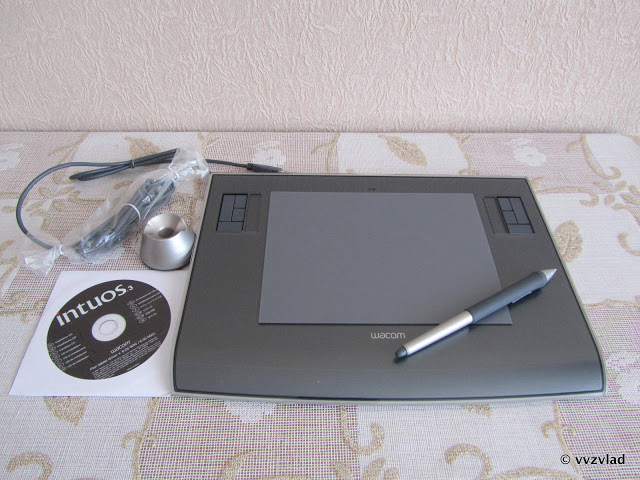
The principle of their work is also not prohibitively complicated - the stylus transmits (signal) at a certain frequency, and the antenna inside the tablet accepts. The controller can find out the exact position due to the tricky shape of the antenna, and information about the pressure on the stylus is transmitted by frequency or code transmissions.
Sly antenna inside the graphics tablet:

Exactly the same system is implemented inside the Galaxy Note (both I and II). There is a glass on top, on the back of which is a capacitive sensor, under it is a screen, and under it is a receiving-transmitting antenna for the stylus.
Here, to make it clearer - I drew a picture.
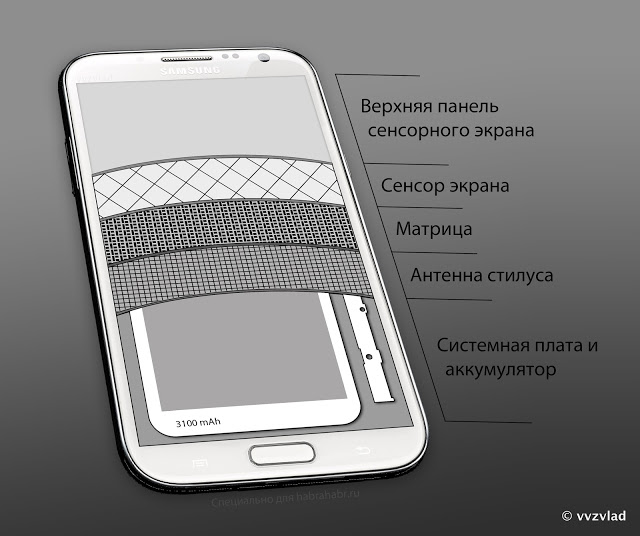
And here is the touch screen controller from Wacom (blue), which manages all this tricky housekeeping, and the cable to the antenna (green):
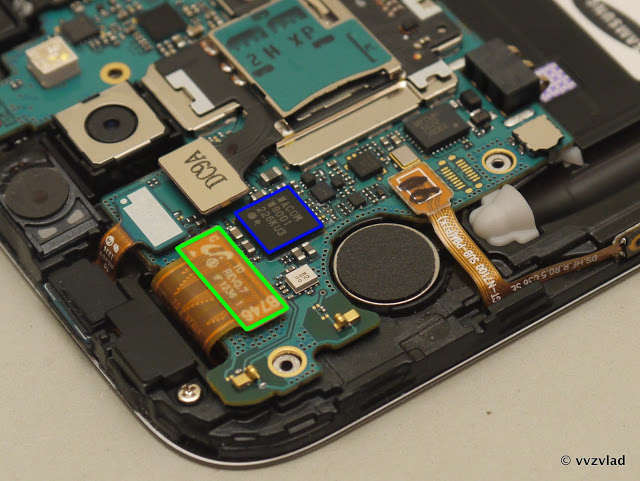
However, an approximate description of the technology is not enough to satisfy my curiosity. Still a little bit, and I would decide to disassemble the stylus, but found the site of fellow microsin-a, who had already done it. Photos of the disassembled stylus belong to him.
Here's how it looks from the side:

Part of the body is removed with sandpaper. There are no batteries, hence the pen is powered by the screen. Receiving-transmitting coil closer:

And now without the case:

And the fee:

The scheme is very simple, to some extent even "clumsy." But beautiful and without unnecessary complications.

The simplest oscillating circuit with variable resonant frequency. The frequency can be changed either by changing the capacitance (an additional capacitor is connected through a button, and accordingly, responds to its pressing), or through a change in inductance - by changing the distance between the two parts of the core on which the coil is wound.
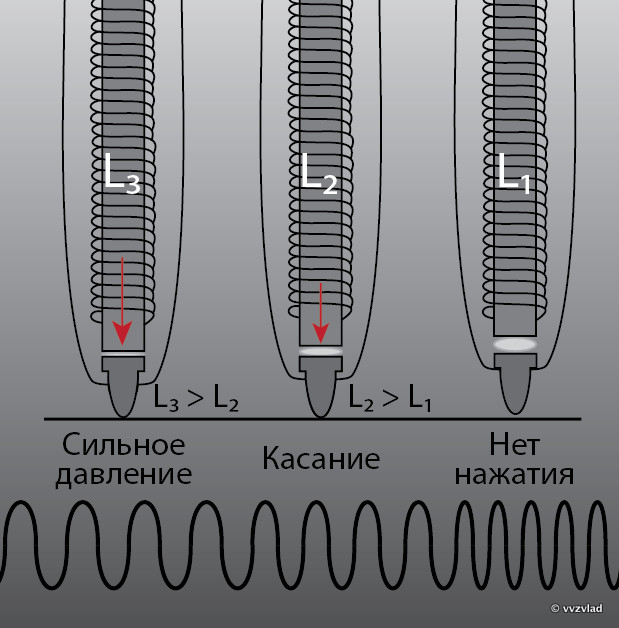
And the distance changed due to the pressure on the tip of the stylus - it was transferred to a soft silicone pad, and led to a change in its shape, and hence the gap.
What am I telling, I have a photo:

It is the same, 1 is a gasket, 2 is the second part of the core, 3 is the tip.
The tip also consists of two parts - a plastic support and a fluoroplastic tip:
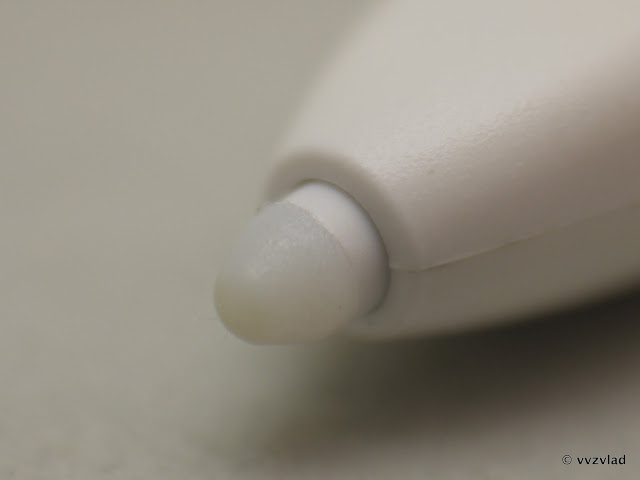
What is interesting is that a stylus with such a design does not need a screen as such, to define a touch, it is enough to bring it to the screen and press the tip with your finger, and the controller will still register a click.
If you fix the tip of the stylus with scotch tape - you can draw with a wave, without touching the screen.
So let's summarize.
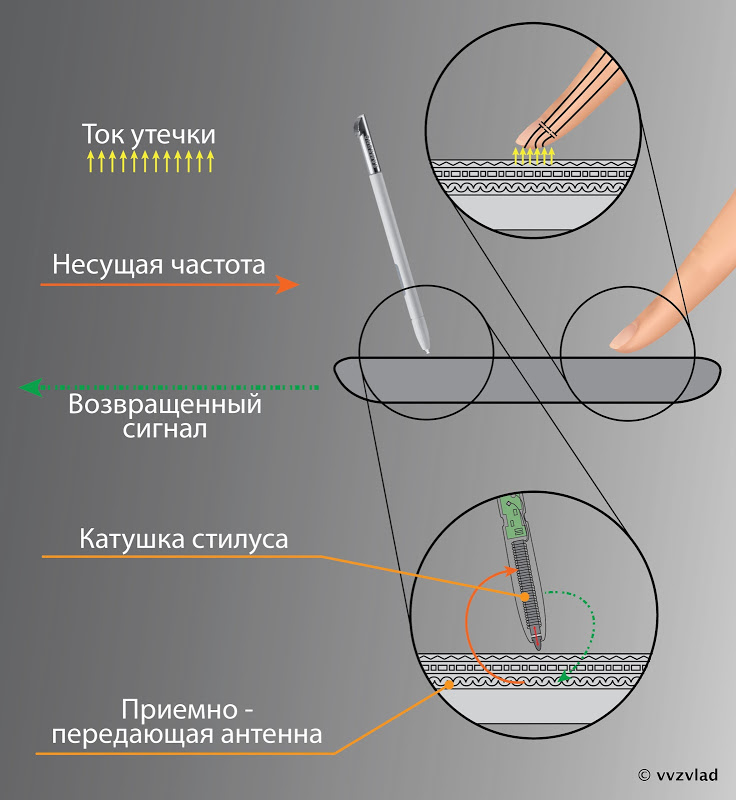
The antenna grid located under the screen generates pulses with a certain frequency (judging by estimates - tens of kilohertz), in the picture they are designated as the carrier frequency - the orange arrow. These pulses are received by an inductance coil located in the stylus, which is part of an oscillating circuit. The contour is designed in such a way that after its “buildup” it is able to oscillate itself for some time, at its resonant frequency, gradually spending the stored energy on heating and radiation. Of course, the heating there is minimal, at a fraction of a degree, as is the radiation, which is already diminishing in a few centimeters. But energy, too, is wasted a little, and probably worked a lot on efficiency.
The oscillatory circuit, whose resonant frequency depends on the inductance of the coil (which, in turn, depends on the position of the tip), and on the capacitance of the capacitors included in the composition (it depends on the push of a button), radiates at this frequency, which is accepted byanything the same antenna, and induces a current in it.

Now the phone's antenna pulsates a current with a complex shape, consisting of two frequencies - exact “transmitting” and changing “receiving” depending on the state of the stylus. Moreover, at some points of the antenna, the receiving field strength is higher - where the stylus is closest to the screen surface. The controller determines this point, finds its center (this will be the place where the stylus touches), then filters the “transmitting” frequency, and after processing it receives the status of the stylus - pressure on the pen and the button status.
Really interesting? :)
You can see all the photos from the article in its original resolution in the Picasa album .
And you can subscribe in order not to miss new reviews on the company’s page and in my profile (“subscribe” button)

In this article I will try to answer this question by telling a little about interesting technical solutions used in this phone.
To begin, remember the theory.
The capacitive screen determines the point of contact for leakage current when charging a capacitor, the role of one facing of which is the screen of the phone and the other - the human body. On the reverse side of the glass in your smartphone are thin lines of transparent conductive material (you can see them if you look at a certain angle on the screen in good light).Capacitive sensor: mini-capacitors (in the form of the letter H) and conductors in between.

')
The touch screen controller charges and discharges these capacitors with a limited current many times per second, each time measuring the capacitance of each of them, and comparing it with the standard capacity recorded in memory. As soon as you touch your glass with your finger, you become such a large capacitor plate that you can charge.
Naturally, this will require energy, which the controller keeps a sharp eye on. As soon as he discovers that a cell begins to consume a lot of energy (a lot - this is compared to normal consumption, but even for a normal LED it is crumbs), which, with a limited current, turns into an increase in charge time - he realizes that they touched it.
On the basis of information from several capacitors, it is possible to calculate the place and area of contact by quite complex formulas. Or several touches, the number of simultaneously determined touches is limited only by the controller and the screen size (it is very difficult to fit 20 fingers on the screen in 3 ").
This technology has several limitations. For several reasons, such as the inability to position the elements tightly enough (transparency decreases), limited glass conductivity, and the need to cut off interference from accidental touches, pickups, dirt on the screen, etc. I had to be content with a minimum touch area of 5x5 mm.
In addition, an object that touches the screen must have a sufficient capacity of its own, comparable to the capacity of the human body. What do we get in the end? The inability to use gloves (most of them have a sufficiently large resistance to reduce leakage current to a minimum that is not determined by the controller), the need for large styli, which must be galvanically connected to the user's body (therefore, most of them have a metal case).
What input systems work with stylus, can distinguish the force of pressing, and have excellent accuracy? These are electromagnetic antenna systems that are used in the vast majority of graphics tablets.
Wacom graphic tablet with stylus:

The principle of their work is also not prohibitively complicated - the stylus transmits (signal) at a certain frequency, and the antenna inside the tablet accepts. The controller can find out the exact position due to the tricky shape of the antenna, and information about the pressure on the stylus is transmitted by frequency or code transmissions.
Sly antenna inside the graphics tablet:

Exactly the same system is implemented inside the Galaxy Note (both I and II). There is a glass on top, on the back of which is a capacitive sensor, under it is a screen, and under it is a receiving-transmitting antenna for the stylus.
Here, to make it clearer - I drew a picture.

And here is the touch screen controller from Wacom (blue), which manages all this tricky housekeeping, and the cable to the antenna (green):

However, an approximate description of the technology is not enough to satisfy my curiosity. Still a little bit, and I would decide to disassemble the stylus, but found the site of fellow microsin-a, who had already done it. Photos of the disassembled stylus belong to him.
Here's how it looks from the side:

Part of the body is removed with sandpaper. There are no batteries, hence the pen is powered by the screen. Receiving-transmitting coil closer:

And now without the case:

And the fee:

The scheme is very simple, to some extent even "clumsy." But beautiful and without unnecessary complications.

The simplest oscillating circuit with variable resonant frequency. The frequency can be changed either by changing the capacitance (an additional capacitor is connected through a button, and accordingly, responds to its pressing), or through a change in inductance - by changing the distance between the two parts of the core on which the coil is wound.

And the distance changed due to the pressure on the tip of the stylus - it was transferred to a soft silicone pad, and led to a change in its shape, and hence the gap.
What am I telling, I have a photo:

It is the same, 1 is a gasket, 2 is the second part of the core, 3 is the tip.
The tip also consists of two parts - a plastic support and a fluoroplastic tip:

What is interesting is that a stylus with such a design does not need a screen as such, to define a touch, it is enough to bring it to the screen and press the tip with your finger, and the controller will still register a click.
If you fix the tip of the stylus with scotch tape - you can draw with a wave, without touching the screen.
So let's summarize.

The antenna grid located under the screen generates pulses with a certain frequency (judging by estimates - tens of kilohertz), in the picture they are designated as the carrier frequency - the orange arrow. These pulses are received by an inductance coil located in the stylus, which is part of an oscillating circuit. The contour is designed in such a way that after its “buildup” it is able to oscillate itself for some time, at its resonant frequency, gradually spending the stored energy on heating and radiation. Of course, the heating there is minimal, at a fraction of a degree, as is the radiation, which is already diminishing in a few centimeters. But energy, too, is wasted a little, and probably worked a lot on efficiency.
The oscillatory circuit, whose resonant frequency depends on the inductance of the coil (which, in turn, depends on the position of the tip), and on the capacitance of the capacitors included in the composition (it depends on the push of a button), radiates at this frequency, which is accepted by

Now the phone's antenna pulsates a current with a complex shape, consisting of two frequencies - exact “transmitting” and changing “receiving” depending on the state of the stylus. Moreover, at some points of the antenna, the receiving field strength is higher - where the stylus is closest to the screen surface. The controller determines this point, finds its center (this will be the place where the stylus touches), then filters the “transmitting” frequency, and after processing it receives the status of the stylus - pressure on the pen and the button status.
Really interesting? :)
You can see all the photos from the article in its original resolution in the Picasa album .
And you can subscribe in order not to miss new reviews on the company’s page and in my profile (“subscribe” button)
Source: https://habr.com/ru/post/160793/
All Articles